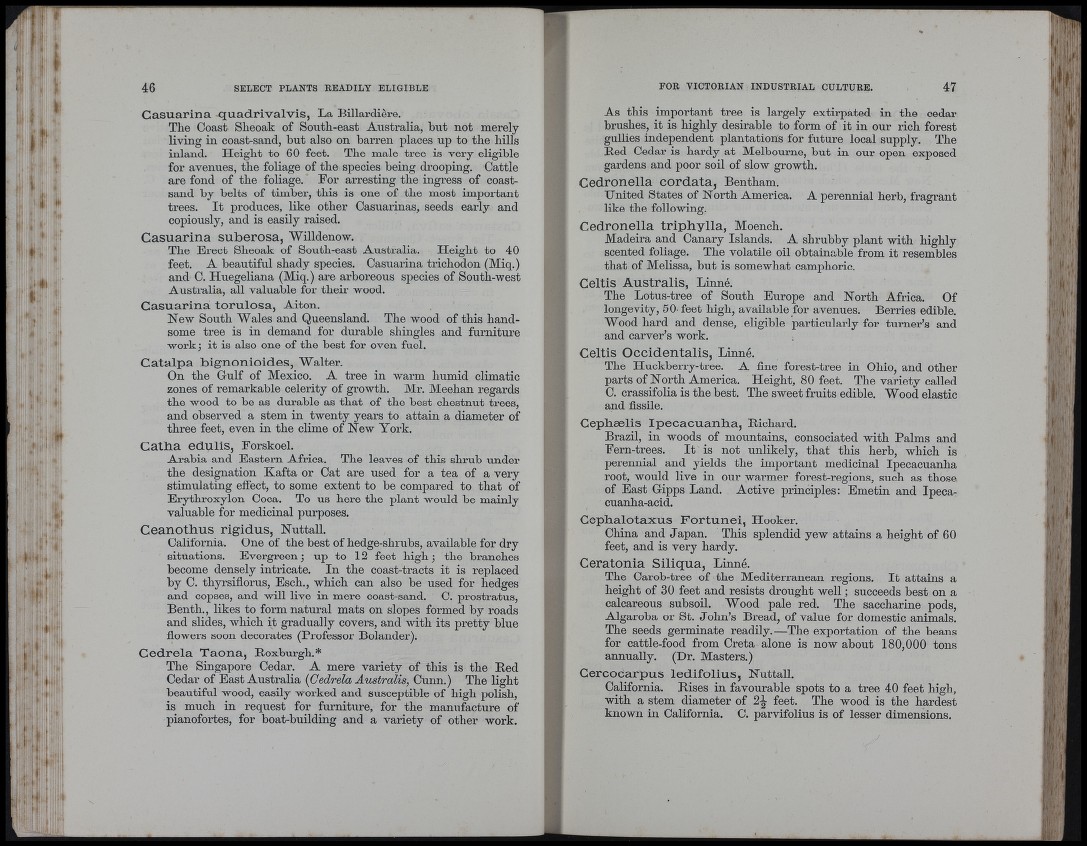
li
i.
«
íi
Casuarina quadrivalvis, La Billardiéi-e.
The Coast Sheoak of South-east Australia, but not merely
living in coast-sand, but also on barren places up to the hills
inland. Height to 60 feet. The male tree is very eligible
for avenues, the foliage of the species being drooping. Cattle
are fond of tbe foliage. For arresting tbe ingress of coast-
sand by belts of timber, this is one of the most important
trees. I t produces, like other Casuarinas, seeds early and
copiously, and is easily raised.
Casuarina suberosa, Wüldenow.
The Erect Sheoak of South-east Australia. Height to 40
feet. A beautiful shady species. Casuarina trichodon (Miq.)
and C. Huegeliana (Miq.) are arboreous species of South-west
Australia, all valuable for their wood.
Casuarina torulosa, Aiton.
New South Wales and Queensland. The wood of this handsome
tree is in demand for durable shingles and furniture
work; it is also one of the best for oven fuel.
Catalpa bignonioides, Walter.
On tbe Gulf of Mexico. A tree in warm humid climatic
zones of remarkable celerity of growth. Mr. Meehan regards
tbe wood to be as durable as that of the best chestnut trees,
and observed a stem in twenty years to attain a diameter of
three feet, even in the clime of New York.
Catba edulis, Eorskoel.
Arabia and Eastern Africa. The leaves of this shrub imder
the designation Kafta or Cat are used for a tea of a very
stimulating effect, to some extent to be compared to th a t of
Erytbroxylon Coca. To us here tbe plant would be mainly
valuable for medicinal purposes.
Ceanothus rigidus, Nuttall.
California. One of the best of hedge-sbrubs, available for dry
situations. Evergreen; up to 12 feet high; tbe branches
become densely intricate. In the coast-tracts it is replaced
by C. tbyrsiflorus, Escb., which can also be used for hedges
and copses, and will live in mere coast-sand. C. prostratus,
Benth., likes to form natural mats on slopes formed by roads
and slides, which it gradually covers, and with its pretty blue
flowers soon decorates (Professor Bolander).
Cedrela Taona, Roxburgh.*
The Singapore Cedar. A mere variety of this is the Red
Cedar of East Ausfralia {Cedrela Australis, Gunn.) The light
beautiful wood, easily worked and susceptible of high polish,
is much in request for furniture, for the mannfactiu’e of
pianofortes, for boat-building and a variety of other work.
As this important tree is largely extirpated in the cedar
brushes, it is highly desirable to form of it in our rich forest
gullies independent plantations for future local supply. The
Red Cedar is hardy at Melbourne, but in our open exposed
gardens and poor soil of slow growth.
Cedronella cordata, Bentham.
United States of North America. A perennial herb, fragrant
like the following.
Cedronella triphylla, Moench.
Madeira and Canary Islands. A shrubby plant with highly
scented foliage. The volatile oil obtainable from it resembles
that of Melissa, but is somewhat camphoric.
Celtis Australis, Linné.
The Lotus-tree of South Europe and North Africa. Of
longevity, 50- feet high, available for avenues. Berries edible.
Wood bard and dense, eligible particularly for turner’s and
and carver’s work.
Celtis Occidentalis, Linné.
The Huckberry-tree. A fine forest-tree in Ohio, and other
parts of North America. Height, 80 feet. The variety called
C. crassifolia is the best. Tbe sweet fruits edible. Wood elastic
and fissile.
Cephaelis Ipecacuanha, Richard.
Brazil, in woods of mountains, consociated with Palms and
Eern-trees. I t is not unlikely, that this herb, which is
perennial and yields the important medicinal Ipecacuanha
root, would live in our warmer forest-regions, such as those
of East Gipps Land. Active principles: Emetin and Ipecacuanha
acid.
Cephalotaxus Fortunei, Hooker.
China and Japan. This splendid yew attains a height of 60
feet, and is very hardy.
Ceratonia Siliqua, Linné.
The Carob-tree of tbe Mediterranean regions. I t attains a
height of 30 feet and resists drought w ell; succeeds best on a
calcareous subsoil. Wood pale red. The saccharine pods,
Algaroba or St. John’s Bread, of value for domestic animal«,
The seeds germinate readily.—The exportation of the beans
for cattle-food from Greta alone is now about 180,000 tons
annually. (Dr. Masters.)
Cercocarpus ledifolius, Nuttall.
California. Rises in favourable spots to a tree 40 feet high,
with a stem diameter of 2^ feet. The wood is the hardest
known in California. C. parvifolius is of lesser dimensions.
'■l: . ,l